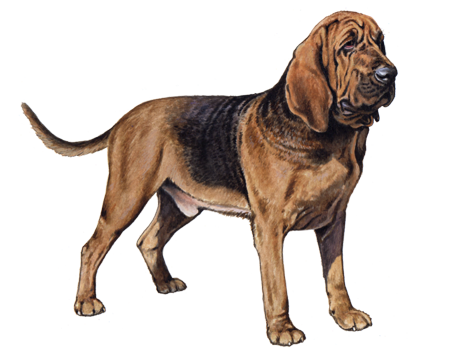
Basset Fauve de Bretagne
There’s a lot to love about the Basset Fauve de Bretagne—a smart and joyful breed. These small dogs are full of energy and, with proper training, make wonderful companions. Like most hunting dogs, Basset Fauve de Bretagnes will let you know when something’s worth chasing by sounding their hound alarm and taking chase.
Interested in discovering if your dog is a Basset Fauve de Bretagne?
Check out Wisdom Panel's DNA tests.

Basset Fauve de Bretagne Traits
General Appearance
There is no mistaking the Basset Fauve de Bretagne’s floppy drop ears and slightly tapered muzzle with furnishings. Bristly like their coat, the Basset Fauve de Bretagne’s tail has a sickle-like curve and tapers to a point.
Coat and Coloring
The Basset Fauve de Bretagne’s coat is short and wiry with a fawn coloring.
Distinctive Physical Traits
The small and stocky Basset Fauve de Bretagne has a strong jawline with lively, dark brown eyes. Their backs tend to be rather short and broad for a Basset breed.
Basset Fauve de Bretagne Temperament
Whether they are hunting or providing companionship, Basset Fauve de Bretagnes excel at whatever they do. They are known to be sociable, as well as affectionate and amenable. Though they enjoy keeping their people company, the Basset Fauve de Bretagne really shines at hunting—using their courageousness and intelligence to outsmart and outrun any prey.
Many of this breed’s excellent hunting traits, such as their endurance, hard-working ethic, and intelligence, make them good pets, as well. With the appropriate amount of exercise, the Basset Fauve de Bretagne can be an agile, lively, and affectionate addition to any household. And early socialization and training can help them be friendly toward strangers and other animals.


Basset Fauve de Bretagne History
The Basset Fauve de Bretagne is a descendent of the now-extinct Grand Fauve de Bretagnes from 1500s France. Before the French Revolution, only aristocrats owned the original line of Bretagnes. But by the late 1700s, the aristocracy had broken up, and the breed grew popular with more people.
As the dog transitioned from trotting alongside horses with aristocrats to providing companionship to hunters and aid to peasants, the Basset breed slowly developed a smaller stature with shorter legs.
Throughout the 19th century, these Bassets gained glory for their ability to hunt a wide range of game—including rabbits, fox, deer, and boar. Today, the breed continues to gain popularity, particularly in France, where Basset Fauve de Bretagnes are still considered excellent hunting dogs.
Basset Fauve de Bretagne Care
Nutrition
As an active and energetic breed, Basset Fauve de Bretagnes need a high-quality dog food that’s suited to their particular age (as well as any additional health concerns).
To prevent weight problems, it’s important to monitor the amount of food and treats that you give your Basset Fauve de Bretagne. Your veterinarian is always a good resource when it comes to determining appropriate nutrition and feeding guidelines.
Grooming
The Basset Fauve de Bretagne’s coarse coat does two things every pet owner hopes for: it resists matting, and it repels dirt. As a result, this breed’s coat is very easy to care for. To keep your pup’s coat healthy and shiny, groom them weekly. Use a fine-toothed comb first to remove loose hair and then a stiff brush for smoothing.
All dogs require regular dental care, including at-home teeth brushing and professional dental cleanings, and the Basset Fauve de Bretagne is no exception. Maintaining good dental hygiene is important for their overall long-term health.
Exercise
Because Basset Fauve de Bretagnes are energetic dogs that were bred to hunt, they require regular, moderate exercise to stay stimulated and healthy. They love hanging with their people, so walks and hikes will help keep them happy. (Just remember to always keep them leashed.)
This smart breed also does well with focused training for sports like agility and obedience.
Training
Though Basset Fauve de Bretagnes are quite smart, sometimes their instinct to hunt can overpower their eagerness to please. So, it’s important to train your pup to control their impulses early. A little patience and dedication can make a big difference when it comes to keeping this breed on course, as they can be stubborn at times.
Basset Fauve de Bretagne Genetic Health Conditions
-
Primary Open Angle Glaucoma (Discovered in Basset Fauve de Bretagne)
Primary Open Angle Glaucoma (POAG) is a disorder that results in an increase in eye pressure, leading to damage to the optic nerve and retina, and blindness if left untreated.
Knowing if your Basset Fauve de Bretagne is a carrier or at-risk for these conditions can help you and your veterinarian plan for your pup’s lifelong care. With Wisdom Panel™ Premium, you can get results for over 200 genetic health tests.
Breed Group
Hound
The most common ancestral trait of this group is being used for hunting. Some use acute powers of scent to follow a trail while others demonstrate the gift of stamina as they run down a quarry. Beyond these two common traits, however, generalizations about hounds are hard to come by as the group is comprised of a very diverse lot of breeds.
Resources
https://www.akc.org/dog-breeds/basset-fauve-de-bretagne/
http://www.fci.be/Nomenclature/Standards/036g06-en.pdf
Reviewed July 26, 2020 by Laura Inman, DVM













































